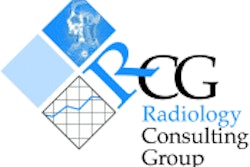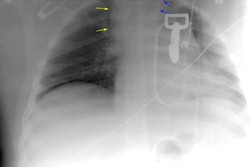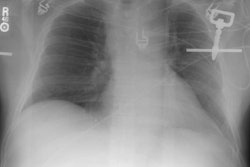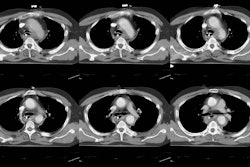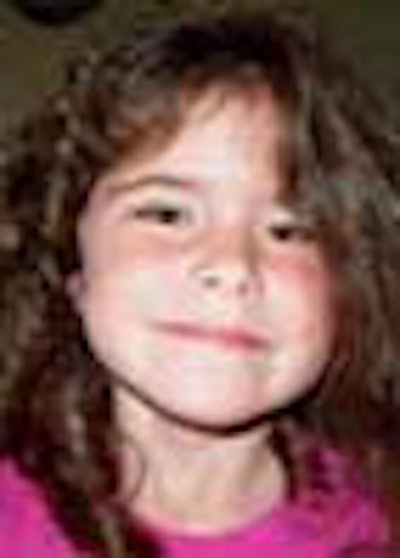
Caught between rising demand and a tight supply, pediatric radiology is testament to the staffing straightjacket that all medical imaging must wrestle with these days. But practitioners say their subspecialty faces unique concerns, not the least of which is a myth of mediocrity.
At the 2003 Society for Pediatric Radiology meeting in San Francisco, three practitioners took a close and sometimes personal look at personnel shortages, workplace issues, and potential solutions that could help their subspecialty -- and all of radiology -- draw more recruits. One unveiled a new online pediatric teaching program that's getting high marks in initial testing.
This, too, shall pass
"Jobs seem to wax and wane in response to a variety of workplace forces," said Dr. Peter Moskowitz, a radiologist at Lucille Packard Children's Hospital in Palo Alto, CA, and director of the Center for Professional Renewal, a career guidance center for physicians. "Those in the room who have gray hair know we went through a time in the '70s when there were almost no jobs in pediatric radiology. That cycled into a surplus of jobs in the (early-to-mid) '80s, and then again in the mid-to-late 90s."
Dr. Mark Halsted, assistant professor of radiology at the Cincinnatti Children's Hospital and Medical Center, saw the roots of today's problems in the advent of HMOs.
"With the rise of the HMOs in the early 80s, the idea was that primary care physicians rather than specialists would be needed in order to control costs...," Halsted said. "During the Clinton era, Hillary was thinking about making universal coverage, and (1993) was interpreted by many to spell the end of specialist compensation."
Then in 1994 came capitation, and with it the since discounted notion that splitting reimbursement among everyone involved in patient care would lower costs, and encourage doctors to keep patients well.
According to Halsted, the political and economic climate of the day led the government, the medical schools and the medical culture to all discourage students' interest in specialization. As a medical student, Halsted said he was strongly (and in his case, unsuccessfully) discouraged from taking up radiology.
But efforts to diminish the role of specialists inadvertently paved the way for today's exploding demand for specialists, Halsted said. The cost-cutters had apparently forgotten about demand.
In fact, Halsted said, installing more primary physicians as gatekeepers all but ensured that more tests would be ordered -- and that demand for imaging studies would rise. The result is an environment where more imaging tests are ordered for less robust reasons, and where imaging studies are a top priority of emergency department physicians.
Today's imaging workload today is 10 times higher than anticipated volume, he said. "The other element is that (facilities) don't want to have a patient in the ER past an eight-hour shift, and they don't want to keep people in the hospital at night for observation because there's pressure to decrease the length of stay for patients," he said. "That all translates into more radiology exams."
To deal with it all, facilities want more staff, and a radiologist in the house 24/7. "They want real-time interpretation and turnaround," Halsted said. "The standards have really changed."
Dr. Janet Reid, Associate Professor of Radiology at the Cleveland Clinic Children's Hospital, said the rising imaging volume is clear in SCORCH (Society of Chairmen of Pediatric Radiology) data. Between 1991 and 1997, inpatient imaging volume rose by 5.9%, outpatient volume by 16%, and resource-based pediatric radiology RVUs by 7%, she said. And according to 2002 SCORCH data, more than 50% of pediatric fellowships went unfilled last year, an increase of 14.6% from 2001 figures.
Misconceptions, fact-finding, and a new online poll
Residents often have misconceptions about pediatric radiology, Reid said, including the idea that it pays less than adult radiology, requires more call, and offers a work environment that is anything but leading-edge. Addressing these misconceptions and improving pediatric radiology's reputation will depend on changing attitudes among the larger community of radiologists, she said, not just among medical students and residents.
As for work environment, Reid said that a study in the American Journal of Roentgenology found that 72% of pediatric radiologists work in academic centers, 65% work in large metropolitan areas, and 50% perform neuroradiology (AJR, May 2000 174:5, pp. 1203-1209).
The Society for Pediatric Radiology is hoping for big response to its new summer survey of residents, now available at http://www.pedrad.org/surveys. The 20 questions can be answered in about 5 minutes, Reid said, and will be invaluable in gauging residents' current views.
What else do residents think about pediatric radiology? According to Moskowitz, there are some clues in the 2002 SPR survey, which gathered the views of a roughly even number of residents in all four years. The results found pediatric radiology appealing in its "interesting case material" (67% of respondents), the use of multiple imaging modalities (51%), working with children (47%), and the subspecialty's overall academic orientation (33%), Moskowitz said.
But ironically, 40% of residents said job opportunities were poor in pediatric radiology, Moskowitz said. Twenty-seven percent said that excessive night call was a disadvantage. Twenty-four percent said salary levels were lower than that of radiology as a whole.
None of these views could easily be proved with available data, and anecdotally there is reason to believe they are likely false, the presenters said. Pediatric radiologists' salaries vary widely by institution, but are not necessarily lower than those of other radiologists, they said.
Phil Miller of Merritt, Hawkins and Associates, a nationwide physician recruiting firm based in Irving, Texas, said his firm places only a few pediatric radiologists each year. However, those recruits are getting paid at least as much as general radiologists.
"The recruiters who have done this type of search indicate that salaries for pediatric radiologists are slightly higher than what regular radiologists are offered -- the general range is $325,000 to $400,000, depending on how urgently the radiologist is needed," Miller told AuntMinnie.com. "If the pediatric radiologist is going into a group where there are other pediatric rads and they can share call, you can offer them less. If they are the sole pediatric radiologist in the area, the offer generally will be toward the upper end of the range, closer to $400,000. We only do a handful of these, of course, so our income figures are based on a limited number of searches."
A residents discussion group held to formulate the survey brought some interesting ideas about salary, according to Reid.
"Half of the group said, 'everybody knows that pediatric radiologists don't make any money, and that's why they're not going into the field,'" according to Reid. "The other half of the group said 'No, that's not true at all.'"
"I don't know where the (negative) perceptions are coming from, Moskowitz said, "but I think there's food for thought here as we think about ways to make our field more attractive. We certainly need good statistics. And we need to get that (information) to our trainees so that we have factual information about our own field."
Not enough radiologists
The increased demand for pediatric imaging studies comes just as many senior radiologists are retiring, Moskowitz said. The silver lining is that it might be possible to recruit some of them back to work, lending the benefit of their expertise throughout radiology.
In a 2000 RSNA survey of radiologists, 78% of those responding said their offices were understaffed, Moskowitz said. The ratio of radiologist jobs to job seekers has also increased, from 3.1 to 1 in 1998, to 3.8 to 1 in 2001. For physicians of all types, the U.S. faces an estimated shortfall of 200,000 doctors by 2020.
"We have a crisis on our hands that's not likely to get corrected overnight," he said.
Workplace woes
There is also evidence of widespread job dissatisfaction, fatigue and burnout among all radiologists on the job. In a 1990 survey by the Reston, VA-based American College of Radiology, 70% of all radiologists said they were satisfied with their careers, Moskowitz said. By 1995, satisfaction had dropped to 50% of those polled.
A 2001 survey by Diagnostic Imaging had 70% (of 108) radiologists saying they were either overworked or already burned out. Interestingly, he said, 47% of respondents said they used "food, sex, drugs, alcohol, getting angry, (or) avoiding the problem" to cope with job stress.
"If you had (even) one of those negative coping strategies, there was a high correlation with poor satisfaction and burnout," he added.
Intergenerational conflicts in the workplace may play an increasing role in job dissatisfaction, Moskowitz said. Baby Boomers (those born 1945-1957) traditionally emphasize hard work and service. And they believe in teamwork, though some are a little challenged by technology.
In contrast, he said, younger generations (including "Cuspers" born 1960-1968, "Busters" born 1969-1978, and "Netsters" born 1979-1984) tend to be "more guided on principles and on personal satisfaction when it comes to careers. They're more interested in predictable hours, they don't want to just work until the work is done. Life balance and family life is a high priority for them, and they're willing to sacrifice in order to get that. They tend to think more in individual terms than in teams. They like to be independent and they like to work independently. And we know they're pretty savvy with computers."
Interest in pursuing fellowships has declined as well, though preliminary indications point to a potential rebound ahead. In 2002, for example, only 20 of 78 fellowship slots in the U.S. entered the job market, Moskowitz said. The SPR conducted a survey of radiology residents last year to assess their attitudes toward pediatric radiology.
"Half (of 106 respondents) said they have considered a career in pediatric radiology and 42% intended to pursue a fellowship in some field, but interestingly, zero had decided to pursue a career in pediatric radiology," he said. "Suddenly we're seeing a lot of people going directly into practice without fellowship training."
The upswing
The good news is the fellowship crisis, and perhaps the surplus of all jobs, may be easing. In April 2003, Moskowitz and Dr. Gary Hedlund from the Primary Children's Medical Center in Salt Lake City, UT, conducted an e-mail spot survey of training centers around the U.S. Forty-one of the 52 centers responding (of 78 centers in total) reported that their fellowship positions had been filled for July 2004. As of June 12, 2003, there were 18 fellowship positions and 141 pediatric radiology positions of all kinds listed on the SPR's Web site.
The apparent rise in demand bodes well for pediatric radiology, Moskowitz said. "People, for whatever reason, are hearing about the large number and the variety of jobs in the job market and they're deciding to go back in the field, at least I suspect that's part of it. The cyclical job market is largely economics-driven in that the supply falls off rapidly in times of poor job prospects, and increases when jobs become more plentiful."
More and better data will be needed to address workplace issues thoroughly, he said, and funding, perhaps in the form of grants, will be needed to acquire the data. The apparent job dissatisfaction in pediatric radiology parallels the malaise seen across the spectrum of radiology practice, he said. Workplace issues, compensation and coping strategies will all need to be addressed thoroughly.
"How can we look at the work environment, whether it's in teaching centers or in private centers, and make work more fun? (Provide) more vacation, more funding research, find ways that people can enjoy their lives as pediatric radiologists," he said.
Pediatric radiologists must become more visible advocates of children's health, in which they already play a critical role, Moskowitz said. Recruiting people who like to work with children, for example pediatricians, could steer the right people into pediatric radiology. Funding support for fellowships could spur participation, he said.
And to the extent that negative perceptions of pediatric radiology are untrue, Moskowitz believes it will be worth the effort to dispel them. "The grass may not be greener in other fields, and the grass may not be greener in private practice," he said.
Halsted had some ideas on making pediatric radiology a better place. First off, residents and medical students need to be welcomed into the department, given the broadest possible exposure, and not overburdened with work or call.
"We can distinguish ourselves from other fields in medicine simply by making them feel like people who have valid opinions, whom we would enjoy having as colleagues," he said. "We can reassure them that job opportunities as available."
At the Cincinnati Children's Hospital, medical students are included in radiology research teams, Halsted said. The students' names are included when the work is published in journals. Residents are trained in across modalities in multiple organs, in a comprehensive effort to teach the workflow from beginning to end.
"We try to use an interdisciplinary approach," Halsted said. "We make rounds more engaging. We ask medical students and residents rotating in other services to give differentials and to describe the findings."
Halsted is not worried about long-term prospects for the field. The fundamentals haven't changed, he said, and pediatric radiology is as wonderful and as interesting as ever. "If we take an 85-year-old and diagnose a tumor, it's not going to have a huge impact on their lives," Halsted said. "But if we cure a little kid of cancer it has a huge impact."
Attracting more radiologists means creating a positive environment, he said, one in which radiologists have time to teach the residents properly. Research time must be protected and encouraged, vacation time increased, call frequency reduced. Hiring more support staff such as ACR-trained radiologist assistants will reduce interruptions, ease the administrative burden, and make radiologists more productive. Teleradiology could enable more reading from home, freeing some practitioners from feeling trapped in the hospital.
"If (residents) see that we can't always staff our departments, they may wonder what's wrong with this job," Halsted said. "And if they see only overworked and stressed staff, they're going to wonder why anyone would ever choose to do this."
Electronic teaching modules
Meanwhile, Reid and her colleagues at the Cleveland Children's Hospital are making steady progress on a series of Web-based electronic teaching modules for pediatric radiology, adapted in part from a 1995 teaching curriculum of 130 pediatric diseases by Drs. W. L. Smith and A. E. Schlesinger (Pediatric Radiology 1995, Vol. 25:5, pp. 403-407).
When completed, the 80 modules will cover 80 childhood conditions using a multimodality emphasis. So far the group has completed about 33 modules, and has signed up 49 outside authors to assist with the rest, Reid said. The project is being funded jointly by the Society for Pediatric Radiology and the Cleveland Children's Hospital.
 |
| Above, pediatric training modules get high marks from users. Image courtesy of Dr. Janet Reid. |
"They are disease-based total learning modules, with pre- and post-testing, a lot of interactive images, and some nice ways to enhance images ... and all original artwork, Reid said. "Presently it's internally peer-reviewed by pediatric radiologists. My plan is to develop an external review board that will consist of a Web guru, someone who is an expert in education, and a pediatric radiologist."
The Pediatric Radiology Curriculum test site can be accessed at http://pediatricradiology.clevelandclinic.org/.
In preliminary testing among radiologists and residents of all levels, "everyone had statistically significant improvement between pre- and post-test scores, so that's great," Reid said.
By Eric BarnesAuntMinnie.com staff writer
June 26, 2003
Copyright © 2003 AuntMinnie.com




